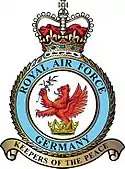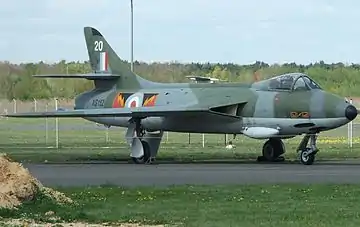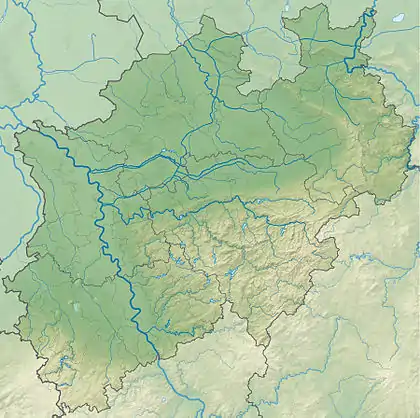Royal Air Force Germany
The former Royal Air Force Germany (RAFG) was a command of the Royal Air Force and part of British Forces Germany. It consisted of units located in Germany, initially as part of the occupation following the Second World War, and later as part of the RAF's commitment to the defence of Europe during the Cold War. The commander of RAFG doubled as commander of NATO's Second Allied Tactical Air Force.
| Royal Air Force Germany | |
|---|---|
 | |
| Active | 1 January 1959 - 1993 |
| Country | Germany |
| Allegiance | |
| Branch | |
| Part of | British Armed Forces, UK Ministry of Defence |
| Nickname(s) | RAFG |
| Motto(s) | Keepers of the Peace[1] |
| March | Royal Air Force March Past |
History

.jpg.webp)
From 1954 Canberra bombers equipped 69 (briefly), 102, 103, 104, 149 Squadrons, and later 59 Squadron at RAF Gütersloh. This force was under Bomber Command control from Britain and had been moved to Germany because of overcrowding of suitable airfields in the UK. With the establishment of the British nuclear bomber forces in the context of NATO's strategy of massive retaliation the Canberra bomber squadrons were again withdrawn from Germany.
After 1955, the majority of the airfields were handed over to the newly established German Air Force and RAF Bückeburg to the army of the German Armed Forces. The number of RAF squadrons were reduced. This was both because of the nuclear strategy of NATO and for financial reasons after the fiasco of the Suez crisis. From 1 January 1959 the command was officially called Royal Air Force Germany, the RAF Second Tactical Air Force (2TAF) renamed. At this time the focus was the flying units already on just six main use airfields RAF Bruggen, RAF Geilenkirchen, RAF Gutersloh, RAF Jever (No. 2 Squadron, Swifts), RAF Laarbruch and RAF Wildenrath. Important aircraft types at this time were the Canberra as night fighting-suited fighter bombers to three and the Hunter as a day fighter stationed at two airports. From 1960 around the clock there were two on alert Canberra loaded with tactical nuclear weapons who were ready within 15 minutes. In addition there were two seasons that the Swift used them as scouts and four squadrons of Gloster Javelin all-weather interceptors. Two English Electric Lightning squadrons - No. 92 Squadron RAF and No. 19 Squadron RAF - arrived in Germany from 1965.
RAF Jever was transferred in 1961 and RAF Geilenkirchen in 1968, reducing the command to four flying airfields. When Geilenkirchen closed, it appears there were two flying squadrons at the station. No. 3 Squadron RAF moved to RAF Laarbruch and No. 92 Squadron RAF moved to RAF Gutersloh.
RAF Germany was disbanded as a separate command in 1993 as part of the reduction of British Armed Forces presence in Europe at the cessation of the Cold War. The remaining RAF forces in Germany ceased to be a separate command, and instead became No 2 Group RAF, part of RAF Strike Command. No 2 Group was then disbanded on 1 April 1996 by being absorbed into No 1 Group RAF.
Flying units in 1989
- Royal Air Force Germany, RAF Rheindahlen, doubles as commander of NATO's Second Allied Tactical Air Force
- 4 Wing, administrative control of RAF Regiment Rapier squadrons based in West Germany
- 33 Wing, administrative control of RAF Regiment Light Armour squadrons based in West Germany
- RAF Bruggen, FRG
- No. 9 Squadron, 12× Tornado GR.1note 1
- No. 14 Squadron, 12× Tornado GR.1note 1
- No. 17 Squadron, 12× Tornado GR.1note 1
- No. 31 Squadron, 12× Tornado GR.1note 1
- No. 37 Squadron RAF Regiment, (Air Defence, 8× Rapier launch stations)
- No. 51 Squadron RAF Regiment, (Light Armour, 15× Spartan, 6× Scorpion)
- RAF Gütersloh, FRG
- No. 3 Squadron, 16× Harrier GR.5
- No. 4 Squadron, 16× Harrier GR.5
- No. 18 Squadron, 16× CH-47 Chinook (supporting British Army of the Rhine)
- No. 230 Squadron, 16× Puma HC.1 (supporting British Army of the Rhine)
- No. 63 Squadron RAF Regiment, (Air Defence, 8× Rapier launch stations)
- RAF Laarbruch, FRG
- No. 2 Squadron, 12× Tornado GR.1A (Reconnaissance)
- No. 15 Squadron, 12× Tornado GR.1note 1
- No. 16 Squadron, 12× Tornado GR.1note 1
- No. 20 Squadron, 12× Tornado GR.1note 1
- No. 1 Squadron RAF Regiment, (Light Armour, 15× Spartan, 6× Scorpion)
- No. 26 Squadron RAF Regiment, (Air Defence, 8× Rapier launch stations)
- RAF Wildenrath, FRG
- No. 19 Squadron, 16x Phantom FGR.2
- No. 92 Squadron, 16x Phantom FGR.2
- No. 60 Squadron, Andover CC.2 transport planes
- No. 16 Squadron RAF Regiment, (Air Defence, 8× Rapier launch stations)
Note 1: Unit with nuclear strike role with 18x WE.177 tactical nuclear weapons.
RAFG Stations & Establishments
| Name | Years active | Current use/Notes |
|---|---|---|
| RAF Ahlhorn | 1945-1958 | now German Airfield Ahlhorner heath |
| RAF Bad Kolgrub | ||
| RAF Barrel Mountain | Army Air Base Barrel Mountain | |
| RAF Blankensee | ||
| RAF Bruggen | 1958-2002 | (UK) Elmpt Station, Javelin Barracks |
| RAF Bückeburg | 1946-1960 | Bückeburg Air Base |
| RAF Butzweilerhof | August 1951 - 31 January 1967 | Residential/Retail Area |
| RAF Celle | 11 April 1945 – 29 November 1957 | Celle Air Base |
| RAF Fassberg | April 1945 - 1 January 1957 | Faßberg Air Base |
| RAF Fuhlsbüttel | ||
| RAF Gatow | 19 August 1945 – 7 September 1994 | General-Steinhoff Kaserne and Bundeswehr Museum of Military History - Berlin-Gatow Airfield |
| RAF Geilenkirchen | May 1953 - March 1968 | NATO Air Base Geilenkirchen |
| RAF Gütersloh | 27 June 1945 – 1993 | Princess Royal Barracks, Gütersloh |
| RAF Hambühren | ||
| RAF Hehn | 11 Signals Unit main communications centre for RAFG and BAOR land line communications | |
| RAF Hustedt | ||
| RAF Husum | a remote radar station on the coast near Husum, Schleswig-Holstein | |
| RAF Jever | April 1945 - 1961 | Jever Air Base |
| RAF Laarbruch | March 1945 - 1999 | Weeze Airport |
| RAF Lübeck | 1945 - 1997 | Lübeck Airport |
| RAF Lüneburg | ||
| RAF Nordhorn | 1945 - March 2001 | air weapons range |
| RAF Nörvenich | -mid-1950s | Nörvenich Air Base |
| RAF Oldenburg | -October 1957 | German Air Force |
| RAF Plantlünne | ||
| RAF Rheindahlen | October 1945 - December 2013 | |
| RAF Schleswigland | 1945 - October 1959 | Schleswig Air Base |
| RAF Sundern | ||
| RAF Sylt | 1945 - 16 October 1961 | Sylt Airport |
| RAF Uetersen | - November 1955 | From November 1948 to March 1950 HQ No. 85 Group RAF, RAF presence until end of November 1955. |
| RAF Wahn | Cologne Bonn Airport | |
| RAF Hospital Wegberg | 1953 - 1 April 1996 | HQ British Forces Germany Health Service (BFGHS) |
| RAF Wildenrath | 15 January 1952 – 1 April 1992 | |
| RAF Winterberg | ||
| RAF Wunstorf | 7 April 1945 - 1957 | Wunstorf Air Base |
See also
References
- Pine, L G (1983). A Dictionary of mottoes. London: Routledge & Kegan Paul. p. 122. ISBN 0-7100-9339-X.
Further reading
- British Garrison Berlin 1945 -1994, "No where to go", W. Durie ISBN 978-3-86408-068-5
| Preceded by Second Tactical Air Force (2TAF) |
RAF Germany 1959–1993 |
Succeeded by No. 2 Group RAF |

